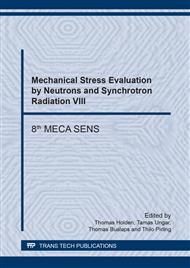[1]
H. F. Poulsen, Three-Dimensional X-ray Diffraction, Springer, Berlin, (2004).
Google Scholar
[2]
H. F. Poulsen, Three-dimensional X-ray Diffraction, in: J. Banhart (Ed. ), Advanced Tomographic Methods in Materials Research and Engineering, Oxford University Press, New York, 2008, pp.249-276.
DOI: 10.1093/acprof:oso/9780199213245.003.0009
Google Scholar
[3]
H. F. Poulsen, An introduction to three-dimensional x-ray diffraction microscopy, J. Appl. Cryst. 45 (2012) 1084-1097.
DOI: 10.1107/s0021889812039143
Google Scholar
[4]
E. M. Lauridsen, S. Schmidt, R. M. Suter and H. F. Poulsen, Tracking: a method for structural characterization of grains in powders or polycrystals, J. Appl. Cryst. 34 (2001) 744-750.
DOI: 10.1107/s0021889801014170
Google Scholar
[5]
W. Ludwig, P. Reischig, A. King, M. Herbig, E. M. Lauridsen, G. Johnson, T. J. Marrow and J. Y. Buffière, Three-dimensional grain mapping by x-ray diffraction contrast tomography and the use of Friedel pairs in diffraction data analysis, Rev. Sci. Instrum. 80 (2009).
DOI: 10.1063/1.3100200
Google Scholar
[6]
M. Moscicki, P. Kenesei, J. Wright, H. Pinto, T. Lippmann, A. Borbély and A. R. Pyzalla, Friedel-pair based indexing method for characterization of single grains with hard x-rays, Mater. Sci. Eng. A, 524 (2009) 64-68.
DOI: 10.1016/j.msea.2009.05.002
Google Scholar
[7]
J. Oddershede, S. Schmidt, H. F. Poulsen, H. O. Sørensen, J. Wright and W. Reimers, Determining grain resolved stresses in polycrystalline materials using three-dimensional X-ray diffraction, J. Appl. Cryst. 43 (2010) 359-549.
DOI: 10.1107/s0021889810012963
Google Scholar
[8]
J. V. Bernier, N. R. Barton, U. Lienert and M. P. Miller, Far-field high-energy diffraction microscopy: a tool for intergranular orientation and strain analysis, J. Strain Anal. Eng. Des. 46 (2011) 527-547.
DOI: 10.1177/0309324711405761
Google Scholar
[9]
J. K. Edmiston, N. R. Barton, J. V. Bernier, G. C. Johnson and D. J. Steigmann, Precision of lattice strain and orientation measurements using high-energy monochromatic X-ray diffraction, J. Appl. Cryst. 44 (2011) 299-312.
DOI: 10.1107/s0021889811002123
Google Scholar
[10]
C. C. Aydiner, J. V. Bernier, B. Clausen, U. Lienert, C. N. Tome and D. W. Brown, Evolution of stress in individual grains and twins in a magnesium alloy aggregate, Phys. Rev. B 80 (2009) 024113.
DOI: 10.1103/physrevb.80.024113
Google Scholar
[11]
J. Oddershede, B. Camin, S. Schmidt, L. P. Mikkelsen, H. O. Sørensen, U. Lienert, H. F. Poulsen and W. Reimers, Measuring the stress field around an evolving crack in tensile deformed Mg AZ31 using three-dimensional X-ray diffraction, Acta Mater. 60 (2012).
DOI: 10.1016/j.actamat.2012.02.054
Google Scholar
[12]
L. Wang, J. Lind, H. Phukan, P. Kenesei, J. S. Park, R. M. Suter, A. J. Beaudoin and T. R. Bieler, Mechanical twinning and detwinning in pure Ti during loading and unloading – An in situ high-energy X-ray diffraction microscopy study, Scripta Mater. 92 (2014).
DOI: 10.1016/j.scriptamat.2014.08.008
Google Scholar
[13]
H. Abdolvand, M. Majkut, J. Oddershede, J. P. Wright and M. R. Daymond, Study of 3-D stress development in parent and twin pairs of a hexagonal close-packed polycrystal: Part I – in-situ three-dimensional synchrotron X-ray diffraction measurement, Acta Mater. 93 (2015).
DOI: 10.1016/j.actamat.2015.04.020
Google Scholar
[14]
Y. Hayashi, Y. Hirose and Y. Seno, Polycrystal orientation mapping using scanning three-dimensional X-ray diffraction microscopy, J. Appl. Cryst. 48 (2015), 1094-1101.
DOI: 10.1107/s1600576715009899
Google Scholar
[15]
Information on http: /sourceforge. net/p/fable/wiki/imaged11.
Google Scholar
[16]
G. Simmons and H. Wang, Single Crystal Elastic Constants and Calculated Aggregate Properties: A Handbook, MIT Press, Cambridge, (1971).
Google Scholar
[17]
S. Matsuyama, H. Mimura, H. Yumoto, H. Hara, K. Yamamura, Y. Sano, K. Endo, Y. Mori, M. Yabashi, Y. Nishino, K. Tamasaku, T. Ishikawa and K. Yamauchi, Development of mirror manipulator for hard-x-ray nanofocusing at sub-50-nm level, Rev. Sci. Instrum. 77 (2006).
DOI: 10.1063/1.2349594
Google Scholar


